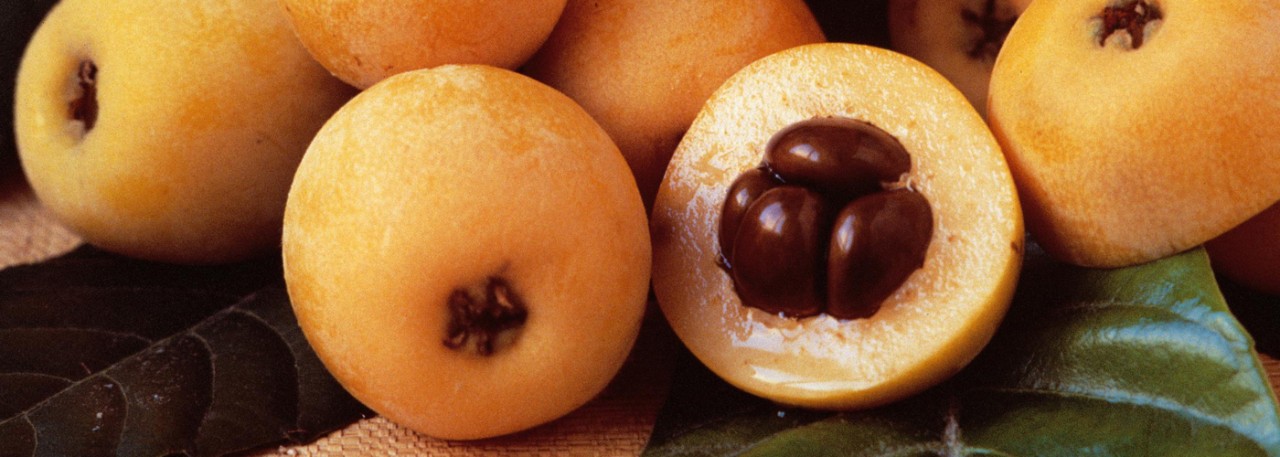.png.transform/rendition-xs/image_image%20(1).png)
Nísperos Callosa d'en Sarrià PDO
Fruits from the Algar, Agerie or Nada varieties (main varieties), the Goiden and Magdall (pollinating varieties), from the Eriobotryae Japonica Lindi species, destined for fresh human consumption.
Tasting notes
Sweet and slightly acidic flavor, with strong, leathery skin. No strange aromas or flavors.
Other notes
Orange or yellowish color. Orange or whitish flesh, shiny and compact. Oval in shape, with occasional elongation to the part attached to the branch.
Quality characteristics: whole, healthy, clean, virtually free from any visible strange material and with abnormal external humidity.
The fruits have sufficiently developed and ripened to allow them to be handled, transported and treated, and to meet all commercial demands set for them at their final destination.
Production / Processing method
Planting is carried out on ungrafted root stock or on the quince tree (Cydonia vulgaris), which is used to ensure that production can begin much more quickly. The most suitable period for planting is in spring. The plantation framework depends on the variety and cultivation system used, and the most usual are 5 x 5 m (16.40 x 16.40 ft) and 6 x 5 m (19.68 x 16.40 ft).
Before planting begins, the land must be well-prepared. A hole with a depth of more than 60 cm (23.6 in) must be used. The holes are opened with sufficient time to allow the roots to develop well, with dimensions of 0.40 - 0.80 m (15.74 -31.46 in). This is, however, variable, and depends on the size of the plant. This tree is very low maintenance, as it has superficial roots, with lots of smaller sub-roots. These should not be located any deeper than 15-20 cm (5.9 -7.84 in).
Pruning aims to achieve well-formed trees, thus obtaining maximum production and the best possible quality. This may be pruning for shaping purposes, when the tree is young, or pruning for fruiting purposes after harvest, which involves suppressing the axis of the flowers that bore the fruits, along with any dead or badly-placed branches.
The loquats are manually harvested, directly from the tree, and only when they are suitably ripe (mainly in April). Cushioned baskets are used for the harvest and transport of the fruit, to avoid any kind of damage.
In the industrial premises, the following treatment and packaging processes are carried out:
-Reception at the factory and pre-storage: The fruit may be stored in a covered, well-aerated area for the amount of time required to ensure perfect coloring.
-Selection, to remove any blemished, damaged, burst or low-color fruit.
-Classification, based on color and size, to ensure uniformity within each commercial category.
-The product is placed in its packaging. The contents of each package will be uniform, and will only contain fruit of the same origin, variety, quality and caliber, all perfectly uniform. The visible part of the package’s contents will be representative of the contents as a whole.
-The loquats are treated in such a way as to ensure suitable protection. Materials used in the interior of the packaging, especially papers, must be new, clean and of such a nature as to cause no alteration to the fruit.
Geography / Relief and climate
Generally speaking the region is fairly hilly, and is crossed by the foothills of the Sistema Bético and the Aitana, Bernia and Almeida ranges, with peaks of between 600 and 1,100 m (1,968 and 3,608 ft). The region’s geological origins can be traced back to the quaternary and tertiary periods and, further to the south, the area also includes alluvial soil.
The subsoil belongs to the Triassic, and is mainly comprised of limestone, shale and gypsum. The land in the area is generally clay-like in nature, rich in calcium carbonate and with low levels of organic materials and phosphorous.
The area has a dry Mediterranean climate, somewhat different to the maritime Mediterranean and subtropical climates of the coast and the Sierras, respectively.
Average annual temperatures range from 15 to 19 º C (59 to 66.2 ºF). The most characteristic trait of this region is the almost total lack of sub-zero temperatures, with the annual average between 9 and 15 º C (48.2 and 59 ºF). Average annual rainfall is between 500 and 900 mm (19-7 and 35.46 in).
The main rivers in the area are the River Algar, which rises in the Sacos strait in Fuente de la Higuera, and crosses the regions of Callosa d’En Sariá (with the River Bolilla its main tributary); the River Guadalest, which rises in Cofrindes and, after crossing Callosa d'En Sarriá, Beniardá, Benimanteli and Guadalest, crosses Altes where it meets the River Algar, both flowing into the Mediterranean. The southernmost part of the region is bordered by the Rivers Sella and Amadorio, which both flow close to Villajoyosa.
Regulatory Council
Consejo Regulador de la DOP Nísperos Callosa d'en Sarrià
C/ Partida Micleta, s/n - Apartado de Correos 84
03510 Callosa d´en Sarriá (Alicante)
Tel: (+34) 965 886 075
do.nispero@nispero.com
www.nispero.com
Sources:
Oval in shape, with occasional elongation to the part attached to the branch.


- /content/dam/en/icex-foodswines/images/products/fruits---vegetables/nísperos-callosa-d'en-sarrià-pdo/Nísperos%20Callosa%20d'en%20Sarrià%20PDO%20carr1.jpg
- /content/dam/en/icex-foodswines/images/products/fruits---vegetables/nísperos-callosa-d'en-sarrià-pdo/Nísperos%20Callosa%20d'en%20Sarrià%20PDO%20carr2.jpg

Callosa d'en Sarrià (Valencian Community)
